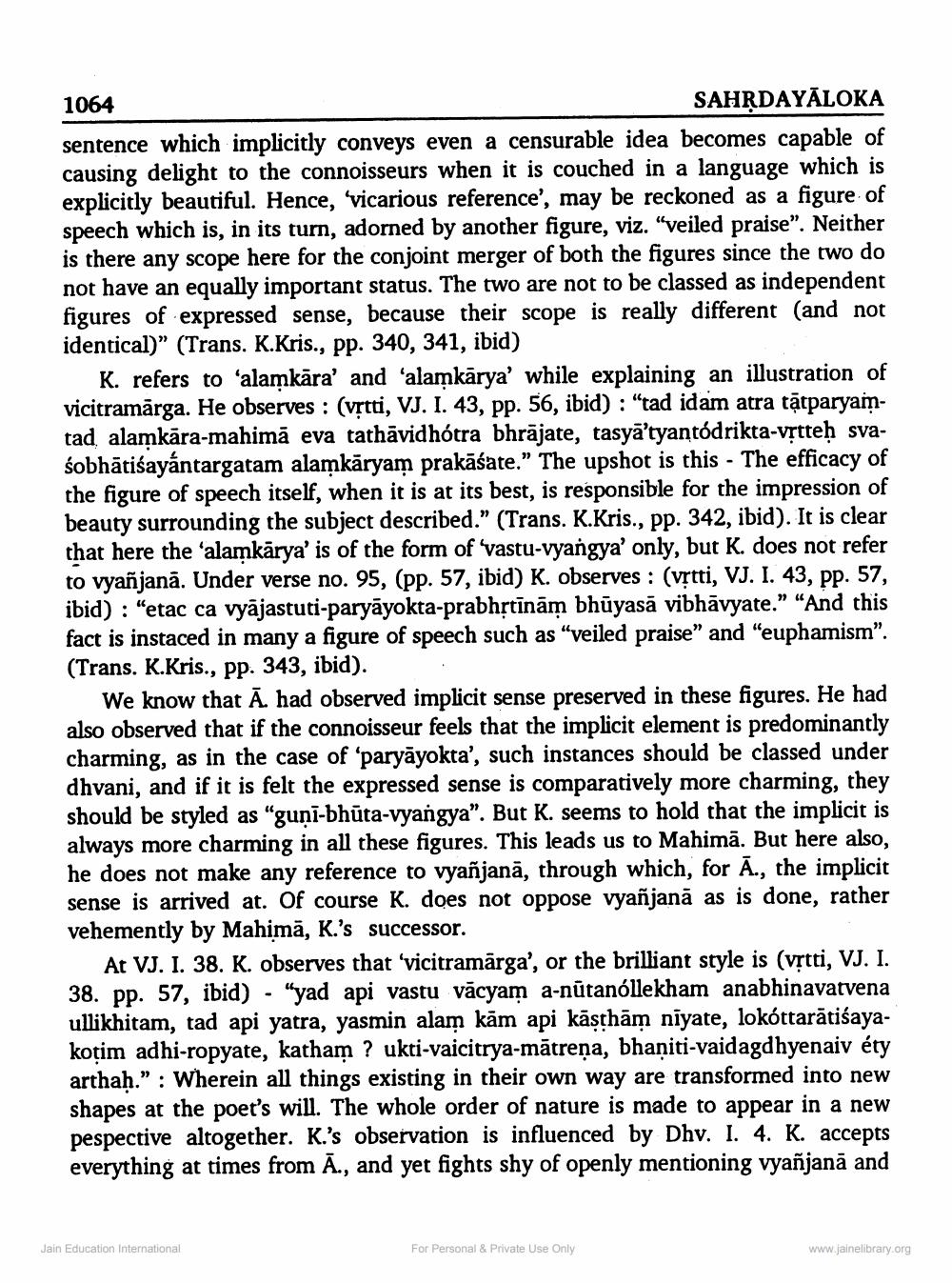________________
1064
SAHRDAYĀLOKA sentence which implicitly conveys even a censurable idea becomes capable of causing delight to the connoisseurs when it is couched in a language which is explicitly beautiful. Hence, 'vicarious reference', may be reckoned as a figure of speech which is, in its turn, adorned by another figure, viz. “veiled praise”. Neither is there any scope here for the conjoint merger of both the figures since the two do not have an equally important status. The two are not to be classed as independent figures of expressed sense, because their scope is really different (and not identical)” (Trans. K.Kris., pp. 340, 341, ibid)
K. refers to 'alamkāra' and 'alamkārya' while explaining an illustration of vicitramārga. He observes : (vrtti, VJ. I. 43, pp. 56, ibid) : "tad idam atra tạtparyamtad, alamkāra-mahimā eva tathāvid hótra bhrājate, tasyā'tyantódrikta-vítteh svaśobhātiśayántargatam alamkāryam prakāśate.” The upshot is this - The efficacy of the figure of speech itself, when it is at its best, is responsible for the impression of beauty surrounding the subject described.” (Trans. K.Kris., pp. 342, ibid). It is clear that here the 'alamkārya' is of the form of 'vastu-vyangya' only, but K. does not refer to vyañjanā. Under verse no. 95, (pp. 57, ibid) K. observes : (vrtti, VJ. I. 43, pp. 57, ibid) : "etac ca vyājastuti-paryāyokta-prabhstīnām bhūyasā vibhāvyate.” “And this fact is instaced in many a figure of speech such as “veiled praise” and “euphamism”. (Trans. K.Kris., pp. 343, ibid).
We know that Ā. had observed implicit sense preserved in these figures. He had also observed that if the connoisseur feels that the implicit element is predominantly charming, as in the case of 'paryāyokta', such instances should be classed under dhvani, and if it is felt the expressed sense is comparatively more charming, they should be styled as “guni-bhūta-vyangya”. But K. seems to hold that the implicit is always more charming in all these figures. This leads us to Mahimā. But here also, he does not make any reference to vyañjanā, through which, for Ā., the implicit sense is arrived at. Of course K. does not oppose vyañjanā as is done, rather vehemently by Mahimā, K.'s successor
At VJ. I. 38. K. observes that 'vicitramärga', or the brilliant style is (vștti, VJ. I. 38. pp. 57, ibid) - "yad api vastu vācyam a-nūtanóllekham anabhinavatvena ullikhitam, tad api yatra, yasmin alam kām api kāsthām niyate, lokóttarātiśayakoțim adhi-ropyate, katham ? ukti-vaicitrya-mātrena, bhaniti-vaidagdhyenaiv éty arthaḥ." : Wherein all things existing in their own way are transformed into new shapes at the poet's will. The whole order of nature is made to appear in a new pespective altogether. K.'s observation is influenced by Dhv. I. 4. K. accepts everything at times from Ā., and yet fights shy of openly mentioning vyañjanā and
Jain Education International
For Personal & Private Use Only
www.jainelibrary.org




